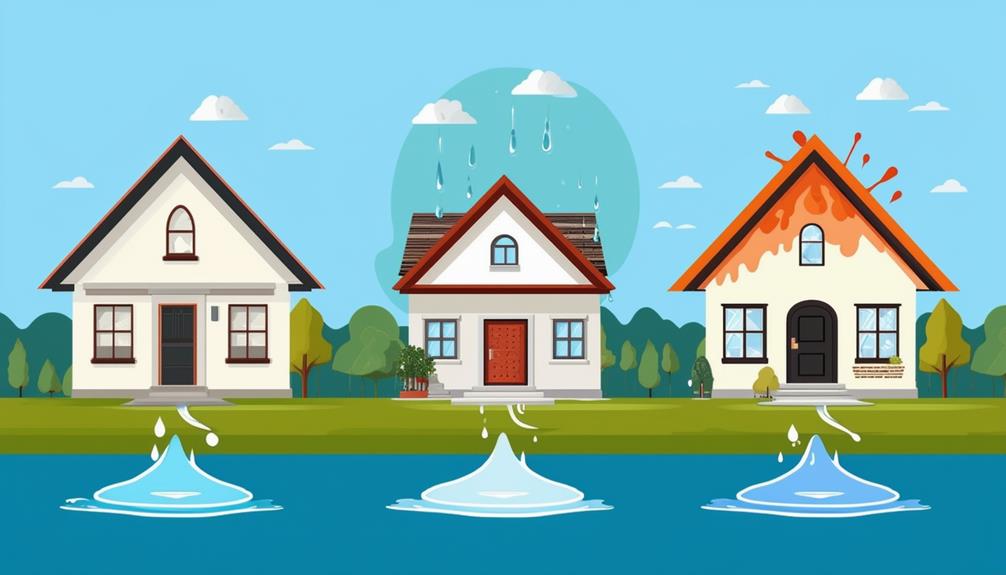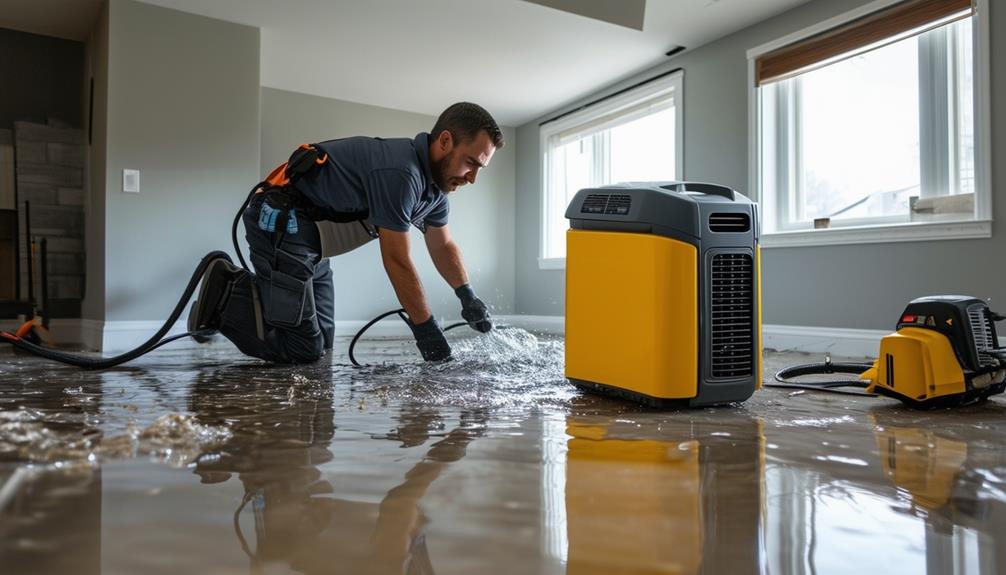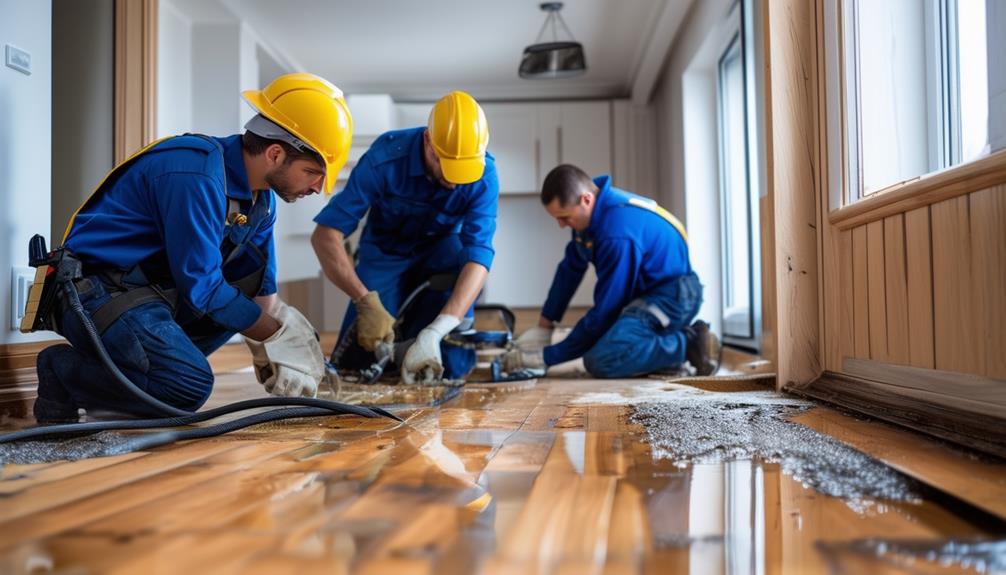Water damage isn't just about excess water; it's about potential structural issues and mold growth. To prevent further damage, stay calm and act swiftly. Assess the damage, prioritize safety, and contact professional help as each type of water damage requires specific treatment. Remember to document everything for your insurance claims. Using professional drying and dehumidification equipment is vital to manage humidity and prevent mold. Sanitize affected areas with the proper equipment and protective gears. Hire reputable professional services with experience and availability for emergencies. You'll find more insights into this and preventive measures as you delve deeper.
Understanding Water Damage Types

Before diving into the repair process, it's important to understand the different types of water damage that can afflict your property. Water damage causes are not all created equal, and each type requires a unique approach for effective mitigation and repair.
Clean water damage, often originating from leaky faucets or burst pipes, is the least hazardous. Grey water damage may contain some contaminants, typically the result of dishwasher or washing machine overflows. The most severe type, black water damage, involves highly polluted water from sources like sewage backups or flood waters, posing significant health threats and requiring immediate professional attention.
Understanding the type of water damage you're dealing with is vital for insurance coverage exploration. Not all insurance policies cover every kind of water damage. Generally, sudden and accidental damage like a burst pipe is covered, while damage resulting from negligence or maintenance issues aren't. Flood damage is typically excluded and requires separate coverage.
Recognizing the types of water damage and their respective causes empowers you to take appropriate action. It allows you to effectively communicate with insurance providers, ensuring you're not left out in the cold when it comes to getting the coverage you need.
Immediate Response to Water Damage
In the face of water damage, your immediate response can greatly impact the extent of the damage and the success of subsequent repairs. You're not alone in this; we're here to guide you, step by step, to mitigate the situation effectively.
Firstly, remain calm. Panic can hinder your ability to react properly. Emergency planning comes into play here. Knowing what to do and acting swiftly can prevent further damage and escalating costs.
Begin with a thorough damage assessment. This involves identifying the source of the water, if it's still active, and the type of water involved – be it clean, grey, or black. Understanding these aspects will dictate your next steps.
Remember, safety is paramount. If the water source is from a broken pipe, shut off the water supply. If it's because of a flood, evacuate if necessary. Always turn off electricity in areas affected by water damage to prevent electrocution.
Contact a professional immediately for further assistance. They're equipped with the necessary knowledge and tools to handle the situation effectively. Be sure to document the damage for insurance purposes.
Your quick response is key. With proper actions, you can control the situation, limit the damage, and pave the way for successful repairs.
Drying and Dehumidification Process

Once you've taken immediate action and assessed the damage, it's time to focus on the drying and dehumidification process to prevent further damage from moisture. This step is essential as it removes excess water and reduces the humidity level in your home to an acceptable level.
Your first task is moisture detection, which involves identifying all areas affected by water. This can be tricky, but it's extremely important as any missed spots can cause mold growth and further damage. The right equipment selection can make all the difference – use moisture meters and infrared cameras to detect hidden water.
Next, you'll need to dry out the area using professional dehumidification and air-drying equipment. The choice of equipment depends on the extent of water damage and the type of materials involved.
To summarize, here's a simple table:
| Steps | Equipment |
|---|---|
| Moisture detection | Moisture meters, Infrared cameras |
| Drying | Air movers, Dehumidifiers |
| Monitoring | Hygrometers, Moisture detectors |
Cleaning and Sanitizing Affected Areas
After the drying process, it's time to roll up your sleeves and start cleaning and sanitizing the affected areas to eliminate any potential bacteria or mold. Remember, mold removal is an essential step in this process. If overlooked, mold can lead to serious health risks and further damage to your property.
To begin, clear out all debris and dust from the affected area. This prepares the surface for an effective disinfection process. Use a vacuum with a HEPA filter to make sure you're catching even the smallest particles. This is a vital step to prevent the spread of mold spores.
Your disinfectant choice is crucial in the cleaning process. Opt for a commercial-grade disinfectant designed to kill bacteria and inhibit mold growth. Apply the disinfectant liberally and allow it to sit for the recommended time before wiping it down. Always wear protective gear, such as gloves and a mask, for your safety during this process.
Lastly, don't forget to clean and sanitize any items affected by the water damage. This includes furniture, appliances, and personal items. By taking these steps, you're not just repairing the damage but ensuring your space is safe and healthy for everyone.
Professional Water Damage Services

As you navigate through the process of water damage repair, professional services can be of invaluable assistance. They'll not only help you identify the source of the damage but implement effective control measures. The key, though, lies in choosing the right professionals for the job.
Identifying Water Damage Source
Before you can start the restoration process, it's crucial to accurately identify the source of the water damage, and that's where professional water damage services come into play. By recognizing damage indicators and mapping out source solutions, they can help prevent further problems.
To identify the source of water damage, consider the following:
- Look for visible signs of water damage like stains, discoloration, and warping on walls, floors, and ceilings.
- Observe for musty odors, a common indicator of hidden mold as a result of water damage.
- Pay attention to unusually high water bills which could indicate hidden leaks.
- Check for damp spots or puddles, especially around appliances that use water.
- Listen for dripping sounds or running water when everything is turned off.
These steps, though straightforward, can be overwhelming when dealing with the emotional toll of damage to your property. You're not alone in this. Professional water damage services are here to help, providing expertise and reassurance during a challenging time. Properly identifying the source of water damage is a critical step towards recovery.
Effective Damage Control Measures
Once you've identified the source of your water damage, it's imperative to take swift and effective damage control measures, and this is where professional water damage services truly excel. These experts employ advanced techniques and tools to mitigate the damage, ensuring you're not stuck with long-term issues like mold growth.
These professionals are also adept at managing insurance claims. They'll document the damage, make accurate estimations, and liaise with your insurance company, relieving you of this challenging task. Remember, a well-documented claim can expedite the process and maximize your reimbursement.
When it comes to water damage, time is of the essence. The longer water sits, the more damage it does, increasing the risk of mold growth. Professionals can rapidly dry out your property, using industrial-grade equipment that you wouldn't typically have access to. They'll also dehumidify your space to prevent future moisture issues.
Professional water damage services are a crucial part of effective damage control. They'll minimize the impact, ensure your insurance claims are handled correctly, and provide the peace of mind that comes with knowing you've taken the best possible action to protect your property. Remember, the goal here is to prevent further damage and restore your space to its pre-damage state.
Choosing the Right Professionals
Navigating the maze of water damage service providers can be overwhelming, so it's important to know what to look for to make sure you're hiring a reliable, competent team. Your professional selection process should encompass the following key points:
- Reputation Evaluation: Delving into online reviews and ratings from previous clients can give you a fair idea of their reliability and service quality.
- Experience and Expertise: Check if they have specific experience in dealing with your type of water damage situation.
- Certification and Training: Make sure they are certified by a recognized body and that their team is trained to handle advanced restoration equipment.
- Immediate Response and Availability: Water damage waits for no one. You need a team that's available 24/7 and responds promptly.
- Detailed Assessment and Transparent Pricing: Look for professionals who provide a thorough damage assessment and a clear, upfront pricing structure.
Water Damage Prevention Measures
To effectively shield your property from water damage, it's important to implement preventive measures that keep moisture at bay. Initially, moisture detection is an essential element in this fight. Equip your property with moisture sensors that can alert you to any unwanted water presence, whether it's a small leak or a significant flooding incident.
Next, invest in waterproofing solutions. Consider having a professional waterproof your basement, the area most prone to water damage. This includes sealing any cracks in the walls and floors and installing a sump pump to remove water that collects in the basement.
It's also a good idea to inspect your roof regularly for potential leaks. Make sure your gutters are clean and direct water away from your house, not towards it.
Keep in mind, a well-ventilated property is less likely to suffer from water damage. Therefore, keep your property well-ventilated, especially areas like the bathroom and kitchen which are more prone to moisture.
These preventive measures may seem like a significant investment, but they'll save you from the costly repairs that water damage can cause. Prevention is always better than cure, and these steps will ensure your property remains safe and dry.
Conclusion
You've now got the knowledge to tackle water damage head-on. Remember, 14,000 people in the U.S face a water damage emergency at home or work every day. Quick response, thorough drying, and effective sanitizing are your weapons against further destruction. Engage professional services when needed and always be proactive with preventive measures. Empowered with this information, you're ready to combat any water damage scenario.
